|
The Concessioner
From "Snap-Shots of the Midway of the Pan-Am Expo"
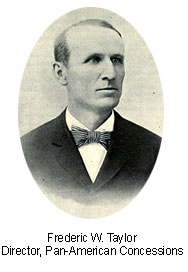 Men
follow expositions as a business. The running of these mammoth shows has almost
become one of the professions. In the principal departments the line of advance
is as surely marked, and the progress of an able man as certain, as it is in any
of the experienced walks of life. Expositions now come so often that a man
may find almost continuous employment with them, and there is about the same fascination
about it that there is about theatrical enterprises. The publicity attained has
a glamour in it, and spectacular success finds sure reward in some more
substantial employment. And there is also the lottery of it. No one can tell just
what an exposition will do; no one knows how far a man may reach if be has
the cunning or the luck to strike the right gait. Men
follow expositions as a business. The running of these mammoth shows has almost
become one of the professions. In the principal departments the line of advance
is as surely marked, and the progress of an able man as certain, as it is in any
of the experienced walks of life. Expositions now come so often that a man
may find almost continuous employment with them, and there is about the same fascination
about it that there is about theatrical enterprises. The publicity attained has
a glamour in it, and spectacular success finds sure reward in some more
substantial employment. And there is also the lottery of it. No one can tell just
what an exposition will do; no one knows how far a man may reach if be has
the cunning or the luck to strike the right gait.
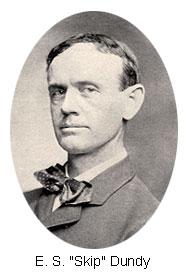 The
business men of the Midway are frequently of consequential origin, and are regarded
as quite an estimable factor in the affairs of the exposition proper. During
the opening months of the Pan-American it was a case of the tail wagging the
dog, for the Midway jumped to the fore in the matter of prominence in the minds
of the public. This resulted mostly from shrewd advertising, but was not entirely
without its merit, for the street possesses the most varied and extensive list
of amusement devices ever offered at one time to any public. It is as a show
that an exposition chiefly appeals to the masses, and as the Midway is its show
end it is not to be wondered at that it should strike the popular fancy. The
Midway Day, managed by the Midway men and filled with their specialties, and,
more than all else, advertised by their methods, brought the largest attendance
that the Exposition had throughout its first half. The
business men of the Midway are frequently of consequential origin, and are regarded
as quite an estimable factor in the affairs of the exposition proper. During
the opening months of the Pan-American it was a case of the tail wagging the
dog, for the Midway jumped to the fore in the matter of prominence in the minds
of the public. This resulted mostly from shrewd advertising, but was not entirely
without its merit, for the street possesses the most varied and extensive list
of amusement devices ever offered at one time to any public. It is as a show
that an exposition chiefly appeals to the masses, and as the Midway is its show
end it is not to be wondered at that it should strike the popular fancy. The
Midway Day, managed by the Midway men and filled with their specialties, and,
more than all else, advertised by their methods, brought the largest attendance
that the Exposition had throughout its first half.
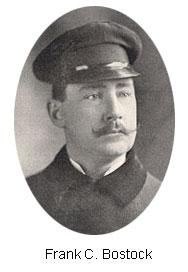 The
Midway concessioner is an ingenious and a shrewd man, and in several cases he
is extraordinarily resourceful. Like all showmen he is fond of big type and
superlative adjectives, and loves the roll of the "aire " with which he usually
announces his interest in a concession. He is a "concessionaire," a sonorous
something that is very much more important than a plain showman. The
Midway concessioner is an ingenious and a shrewd man, and in several cases he
is extraordinarily resourceful. Like all showmen he is fond of big type and
superlative adjectives, and loves the roll of the "aire " with which he usually
announces his interest in a concession. He is a "concessionaire," a sonorous
something that is very much more important than a plain showman.
Among the concessioners there are
several men who have distinct claims to other consideration. There is the professional
designer of Midway attractions, such as Frederic Thompson or Edward J. Austen.
There is the illusionist, such as Henry Roltair, and there is the man who has
made his reputation along other lines and who brings to the Midway a wealth
of experience and a valuable personality. Such a man is Frank Bostock, the owner
of the animal show. The director of amusements, such as Frederic Cummins of
the Indian Congress, is a necessary part of the layout, and the capitalist certainly
is. Most of the Midway's capital, which amounts to more than a million dollars,
is subscribed by Buffalo business men, but some comes from the concessioners
themselves. The most monied man on the Midway is Skip Dundy, who started at
Nashville, cleared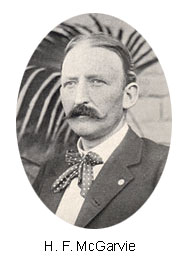 a good deal at Omaha, and came to Buffalo with enough to equip a half dozen
shows. It is his money, mostly, that built A Trip to the Moon and Darkness and
Dawn, and he entirely owns The Old Plantation, the Ariocycle, the horse Bonner
and The Fall of Babylon, besides additional interests in several other places.
E. W. McConnell is the general manager of eight of the largest and most expensive
attractions, known as the Red Star Route. The history of H. F. McGarvie is an
unusual one. He was the director general of a San Francisco exposition held
seven years ago, and at Omaha was the director of publicity through the concluding
months of the fair. He came to Buffalo to take charge of the Bureau of Publicity,
but fell out with the management, and in a moment of inspiration conceived the
scheme of The Streets of Mexico. a good deal at Omaha, and came to Buffalo with enough to equip a half dozen
shows. It is his money, mostly, that built A Trip to the Moon and Darkness and
Dawn, and he entirely owns The Old Plantation, the Ariocycle, the horse Bonner
and The Fall of Babylon, besides additional interests in several other places.
E. W. McConnell is the general manager of eight of the largest and most expensive
attractions, known as the Red Star Route. The history of H. F. McGarvie is an
unusual one. He was the director general of a San Francisco exposition held
seven years ago, and at Omaha was the director of publicity through the concluding
months of the fair. He came to Buffalo to take charge of the Bureau of Publicity,
but fell out with the management, and in a moment of inspiration conceived the
scheme of The Streets of Mexico.
Most of these men began small at
other expositions and have now become influential. Frederic Thompson was an
employee at the 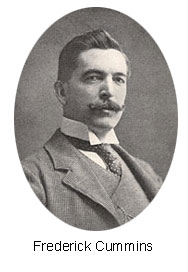 World's
Fair in Chicago; in Buffalo he has designed all but five of the Midway shows
and is one of the chief men. There is the concessioner of small bits, who waits
until the last half of the show, when he knows the crowd is coming, and who
then rents some jagged piece from a big concession, costing perhaps thousands
of dollars, puts on a show costing a few hundred, and takes out more money at
the end of the season than is earned by his neighbor. Such a case is that of
Rhodes and Milligan, spielers for the Indian Congress, who rented a small space
in front of the Spectatorium of Jerusalem, spent $300 on scantling and bunting
for the decoration of a booth for the exhibit of "She," charged ten cents for
a sight of her, and took in more money than did the Spectatorium, whose cost
was $30,000, and whose front is twenty times that of " She." These are the little
men of the Midway. In time they may be as mighty as the big ones. World's
Fair in Chicago; in Buffalo he has designed all but five of the Midway shows
and is one of the chief men. There is the concessioner of small bits, who waits
until the last half of the show, when he knows the crowd is coming, and who
then rents some jagged piece from a big concession, costing perhaps thousands
of dollars, puts on a show costing a few hundred, and takes out more money at
the end of the season than is earned by his neighbor. Such a case is that of
Rhodes and Milligan, spielers for the Indian Congress, who rented a small space
in front of the Spectatorium of Jerusalem, spent $300 on scantling and bunting
for the decoration of a booth for the exhibit of "She," charged ten cents for
a sight of her, and took in more money than did the Spectatorium, whose cost
was $30,000, and whose front is twenty times that of " She." These are the little
men of the Midway. In time they may be as mighty as the big ones.
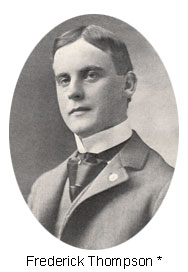
* Inventor of the Aeriocycle, inventor and
manager of the Ship Luna and the Trip to the Moon, architect of the following
Midway buildings: Darkness & Dawn, Moorish Palace, Glass Works, Streets
of Mexico, Old Plantation, Around the World, War Cyclorama, Cleopatra, Beautiful
Orient, Hawaiian Theatre and Volcano, House Upside Down, Dreamland, Gypsy
Camp, Philippine Village, Johnstown Flood, Baby Incubators, Wild Animal Arena,
Venice in America, Chiquita, Esau, Jerusalem - The Crucifixion, with Pabst's
and Lownie's thrown in.
|


 Men
follow expositions as a business. The running of these mammoth shows has almost
become one of the professions. In the principal departments the line of advance
is as surely marked, and the progress of an able man as certain, as it is in any
of the experienced walks of life. Expositions now come so often that a man
may find almost continuous employment with them, and there is about the same fascination
about it that there is about theatrical enterprises. The publicity attained has
a glamour in it, and spectacular success finds sure reward in some more
substantial employment. And there is also the lottery of it. No one can tell just
what an exposition will do; no one knows how far a man may reach if be has
the cunning or the luck to strike the right gait.
Men
follow expositions as a business. The running of these mammoth shows has almost
become one of the professions. In the principal departments the line of advance
is as surely marked, and the progress of an able man as certain, as it is in any
of the experienced walks of life. Expositions now come so often that a man
may find almost continuous employment with them, and there is about the same fascination
about it that there is about theatrical enterprises. The publicity attained has
a glamour in it, and spectacular success finds sure reward in some more
substantial employment. And there is also the lottery of it. No one can tell just
what an exposition will do; no one knows how far a man may reach if be has
the cunning or the luck to strike the right gait.